Table of contents
- Guide: Technology – Motors and Drive Everything about engine lubrication
- Wet sump lubrication
- Husquarna spray oil lubrication
- Dry sump lubrication
- Oil reserves

BILLION
counselor
workshop
Guide: Technology – engine lubrication
Guide: Technology – Motors and Drive
Everything about engine lubrication
To ensure engine lubrication, a sufficient amount of oil must be stored. There are different methods of creating this oil reservoir.
Werner Koch
01/21/2010
It was not as easy as the designers had thought of the engine lubrication for their four-stroke cross machines in the early 1980s. Back then, the Swedish technicians from Husqvarna planted an air-cooled cylinder with a four-stroke head on the housing of the large two-stroke engine. The oil thrown into the crankshaft drive should suffice for lubrication; a pump was dispensed with. Although the shafts running in roller bearings and the valve train passed this test to a certain extent unscathed, the thermally stressed areas overheated because the extremely small oil volume did not guarantee a sufficient cooling effect. This more than meager, albeit very light and simple system of spray oil lubrication has not caught on in any motorcycle engine.
Buy complete article
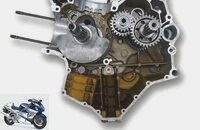
Guide: Technology – Motors and Drive
Everything about engine lubrication
4 pages) as PDF
€ 2.00
Buy now
Simple, light and reliable: wet sump lubrication is standard in engine construction today
The advantages of this system: You only need an oil pump and apart from the oil cooler no other external hose connections are required. The complete oil circuit takes place inside the motor housing.
If the oil pan is large enough, the oil can cool down sufficiently. In addition, with an ample oil reservoir with a large surface area, there is enough time for the gas and air bubbles contained in the oil to escape.
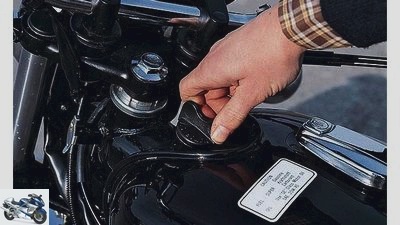
archive
Yamaha was one of many manufacturers to use the volume of the frame tubes as an oil reservoir. The dipstick sits in front of the tank.
Over the years, engines have been developed in which the oil sump is significantly lower than the moving engine components of the crank drive and oil bath clutch. In addition, baffles ensure that the oil is well sealed off from the engine. Which also largely eliminates the problem of foaming and the associated mixing with air.
One problem, however, remains: in extreme driving situations, for example during long braking maneuvers from high speeds or a wheelie leaning extremely backwards, the inertia forces the oil to move from the oil pan forwards or backwards into the engine compartment. In this situation, the oil pump can suck in air instead of oil, which leads to a loss of oil pressure at the bearing points and, in the worst case, to engine damage. To avoid this phenomenon, extremely deep-drawn oil pans are installed on the four-stroke racing machines (see cover picture).
Complex, but also absolutely reliable in extreme situations: dry sump lubrication
This reservoir can be housed as a sheet metal tank in the frame (Harley-Davidson), directly in the frame tubes (Yamaha XT 500 to 660) or in a space cast directly onto the engine block (KTM RC8). Regardless of whether the oil tank is high or low, the oil is sucked out of the tank by a second, the so-called pressure pump, and fed into the oil pressure circuit.
The advantages of dry sump lubrication: You can do without an oil pan on the engine housing, which means you gain ground clearance and overall height. Which is particularly advantageous with enduros and rally machines. But the tall Harley-Davidson V2 engines also benefit from the dry sump lubrication and do not require an oil pan, which would reduce the ground clearance enormously.
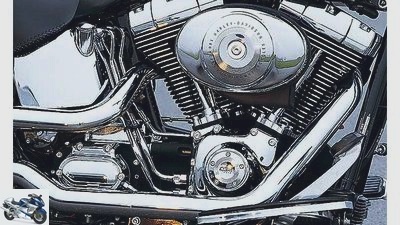
archive
Solid oil tank in the rear frame, steel lines to the engine. Harley-Davidson makes no secret of dry sump lubrication.
In addition, thanks to the free design option, the oil tank can be accommodated in such a way that it fits perfectly into the overall package of center of gravity and mass concentration.
Another advantage: a so-called swirlpot sets the oil into a gentle rotational movement when it enters the oil tank, through which the oil can free itself very well from the trapped air bubbles.
To ensure that there is more lubricating oil in the tank than in the oil pressure circuit, the delivery rate of the return pump is at least 30 to 50 percent higher than that of the pressure pump. Depending on the positioning of the oil tank and the tightness of the pressure pump, the oil level can fluctuate significantly. If the motorcycle is stationary for a long time, the oil flows through the pressure pump into the engine housing, which means that the oil level in the tank is too low. The manufacturer usually stipulates that the oil level should be checked a certain time after the engine has been switched off. This is the only way to ensure that the oil level can be read correctly.
The greatest advantage of dry sump lubrication, however, is that the supply to the pressure pump is guaranteed even when the motorcycle or racing car is exposed to extreme driving situations. No matter how high the inertia forces are, the oil always remains so compact in a correctly designed oil tank that the pressure pump cannot draw air.
The disadvantage of this system: The return pump eats up engine power (approx. 0.2 kW per oil pump), and additional components such as the tank and oil lines increase costs and weight.
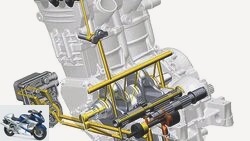
technology & future
Technology guide: lubrication
Knowledge: Nothing works without oil
read more
Wet sump lubrication
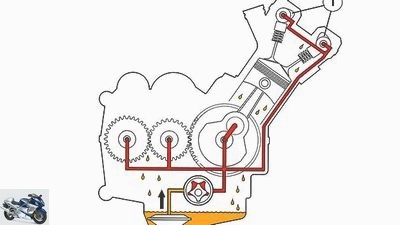
Drawing: archive
Wet sump lubrication sketch.
All that is required here is a pressure pump that sucks the oil out of the large and deeply set oil pan (yellow) and presses it to the lubrication points with a pressure of around 3.5 bar (red circuit). The oil is stored at the bottom of the engine, which significantly increases the overall height. If the oil pan and thus the oil level were installed too high, the crankshaft and clutch would transform the lubricant into a foamy emulsion of air and oil, which of course would drastically impair the cooling and lubricating effect.
While on motorcycles when cornering, the oil hardly escapes to the side due to the inclined position, in four-wheeled vehicles it is pushed to the outer wall of the oil pan due to the high centrifugal forces, which can cause a breakdown of the oil circuit and thus the lubrication in long curves due to insufficient oil level.
With motorcycles, it becomes critical when the driver does long wheelies in a strong position and the oil shifts from the oil pan to the rear of the engine housing. In contrast to the early 1970s, when motorcycle engines often had to struggle with insufficient lubrication of the distant camshaft bearings (1) after a cold start, nowadays powerful oil pumps and sophisticated lubrication systems also reliably supply these bearing points with oil.
Husquarna spray oil lubrication
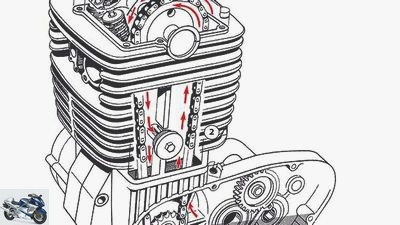
Drawing: archive
The spray oil lubrication developed by Husquarna, which, however, did not catch on.
The four-stroke single-cylinder from Husqvarna were based in the early 1980s on the light and simple two-stroke engines, on the housing of which a four-stroke was simply mounted. To make lubrication as simple and easy as possible, the oil was conveyed from the crankcase to the timing chain (2) via a membrane (1) (Husqvarna Reed Activated Lubrication). This dredged the lubricant more or less reliably upwards in order to lubricate camshafts and rocker arms. The problem with this: The small amount of oil in the engine had to be changed extremely often, because the oil could not be pressed through a fine-pored paper filter due to the lack of a pressure pump and it became soiled extremely quickly. Which even destroyed the rolling bearings of the connecting rod and crankshaft, which were inherently resistant. In addition, the cooling effect was miserable, which especially drove the air-cooled enduro and cross engines into heat collapse in tough off-road use with low airflow but high load.
Dry sump lubrication

Drawing: archive
Sketch of dry sump lubrication.
The schematic representation clearly shows the advantages and disadvantages of this system. In direct comparison to wet sump lubrication, the lower overall height of the oil pan is clearly visible, which improves the ground clearance. A great advantage for enduros or tall engines (Harley-Davidson V2). Thanks to the compact oil tank, which is often provided with baffles, the oil is reliably available for lubrication even with high G-forces (acceleration, braking).
A second pump is required to suck up the oil from the small oil pan and transport it to the oil tank. When entering the oil tank, it is advantageous if the oil jet is swirled and thereby loosens air bubbles from the oil.
The return pump (1) must have a significantly higher delivery rate than the pressure pump (2). This is the only way to ensure that the oil tank is sufficiently refilled in all speed ranges and that the pressure pump cannot suck in air. If the oil tank is placed above the engine housing, the oil seeps out of the tank via the oil pressure pump into the engine when the engine is idle for a long time, which is why the driver’s manuals describe a specific procedure for checking the oil level.
Oil reserves

KTM
Without external lines and placed directly in front of the crankcase, the oil tank on the KTM RC8 moves towards the center of gravity.
In order to accommodate the lubricant in wet sump lubrication, the engine designers came up with a lot. Not only Yamaha used the frame tubes as reservoirs on the XT-500/550/600 series, for example. The big advantage here: the relatively thin front central pipe bunkered the oil in this long shaft so compactly that it fed the oil to the pressure pump even in the event of a fall or extremely steep ascents. The oil level was checked by a dipstick between the steering head and the tank (photo below).
Erik Buell not only used the large frame profiles as a fuel tank, but also the swing arm as an oil reservoir. Flexible lines compensated for the rotary movements. The large surface of the aluminum swing arm, surrounded by the wind, provided a welcome cooling for the oil.
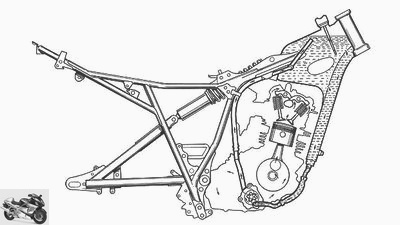
archive
Sketch of the oil tank of the Yamaha XT-500/550/600 series.
Harley-Davidson uses the oil tank as a stylistic element. Chrome-plated or polished, in any case visible with all cables and connections, the Americans rely on pure mechanics.
With the engine of the KTM RC8 stores the engine oil in a tank bladder cast in front of the crankcase. It lies directly in the cooling air flow, does not require any lines or connections and makes the entire engine layout very compact. Yamaha came up with a similar solution with the engines of the TDM- and TRX-850 in the early 1990s.

technology & future
Technology guide: lubrication
Knowledge: Nothing works without oil
read more
Related articles
-
Drawing: archive counselor technology & future Technology guide: lubrication Technology guide: lubrication Knowledge: Nothing works without oil From the…
-
17th pictures archive 1/17 The BMW F 800 engine, with its oil ducts running through it, shows how complex the pressure circulating lubrication is….
-
Technology: BMW S 1000 RR engine in detail
BMW 13th pictures Artist 1/13 The on-board tool kit of the BMW almost ties in with old traditions. With the help of the nine-part set you can strip the…
-
MV Agusta F3 engine: the technology
manufacturer counselor technology & future MV Agusta F3 engine: the technology Technology: MV Agusta F3 engine The engine of the super sports car from MV…
-
Technology: engine technology super sports car
fact 23 pictures fact 1/23 The Honda Fireblade has been a great performer for twenty years. PS takes a close look at the development of engine…
-
Engine cooling technology: Air cooling will soon be obsolete?
Photos: Manufacturer motorcycles Engine cooling technology: air cooling will soon be obsolete? Technology: engine cooling Air cooling will soon be…
-
Technology of the new Ducati engine
counselor technology & future Technology of the new Ducati engine Technology of the new Ducati engine Now it’s getting tight 13 years ago, the four-valve…
-
counselor technology & future Technology: MZ 1000 S engine Technology: MZ 1000 S engine Something that takes a long time…… ……finally drives well,…
-
Technology Superbike developments
Suzuki 16 pictures archive 1/16 Variable valve control Suzuki GSX-R 1000/2016. archive 2/16 Suzuki engine technology in detail: low speed. archive 3/16…
-
Honda CL 350 custom bike: two-stroke engine with 100 hp
Jason Stillgebouer 11 pictures Jason Stillgebouer 1/11 Drew screwed the frame of a Honda CL 350, a two-stroke from Yamaha. Jason Stillgebouer 2/11 The…